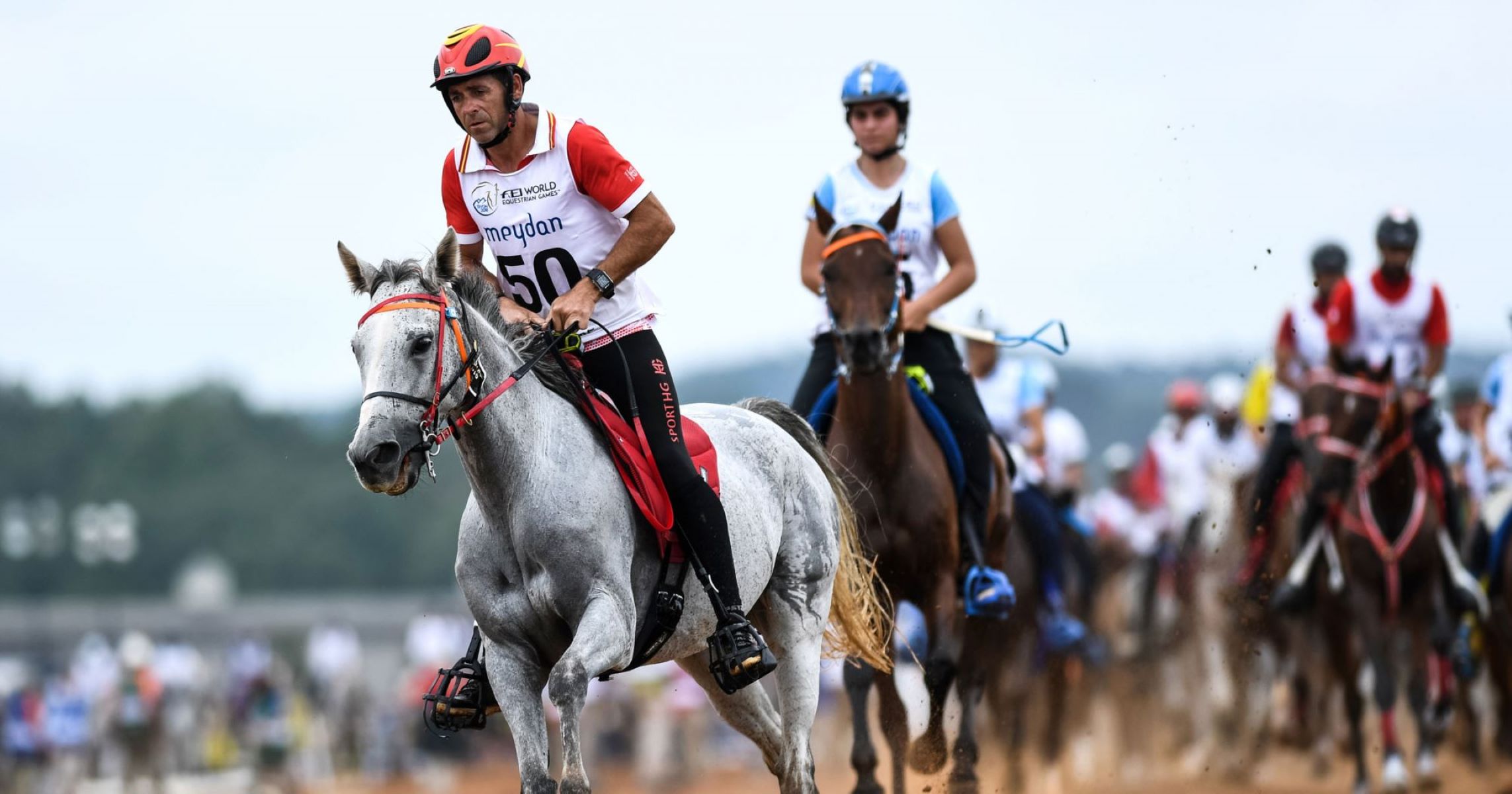

Featured
What Is Endurance Riding
Modified: January 2, 2024
Learn all about endurance riding and why it's a featured activity for equestrians seeking a thrilling and challenging adventure.
Introduction
Endurance riding, a sport that combines horsemanship, athleticism, and a deep bond between horse and rider, has been gaining popularity in recent years. This unique equestrian discipline, often referred to as the ultimate test of horse and rider, involves covering long distances, usually 50 to 100 miles, in a single day or over multiple days. With its roots in long-distance travel and exploration, endurance riding has evolved into a competitive sport, attracting riders from all walks of life.
Unlike traditional horse racing, where speed is the primary focus, endurance riding emphasizes the horse’s ability to maintain a steady and controlled pace over long distances. The physical and mental resilience of both horse and rider are put to the test as they navigate through various terrains and weather conditions. Endurance riders must possess a strong understanding of their horse’s well-being, employing strategies to monitor vital signs and provide appropriate care during the ride.
Endurance riding is not solely about winning competitions; it is also about building a partnership with the horse, experiencing the beauty of nature, and pushing personal limits. Riders often describe the sport as a transformative journey that fosters a deep connection with their equine companions and offers a sense of freedom and adventure.
This article will provide an in-depth exploration of endurance riding, including its history, the structure of competitions, training techniques, necessary equipment and gear, nutrition and care for the horses, and considerations for health and safety. It will also highlight various organizations and associations dedicated to promoting the sport and providing resources for enthusiasts.
So, if you have ever marveled at the stamina and strength of horses or dreamt of embarking on a thrilling adventure that goes beyond the confines of traditional horseback riding, then join us on this journey as we delve into the fascinating world of endurance riding.
What is Endurance Riding?
Endurance riding is a challenging equestrian sport that tests the physical and mental stamina of both horse and rider. It involves covering long distances, typically ranging from 50 to 100 miles, within a specified time frame. The sport places a strong emphasis on the horse’s ability to maintain a controlled pace and recover quickly during rest breaks.
In endurance riding, the welfare of the horse is of utmost importance. Riders must closely monitor their horse’s vital signs, such as heart rate and respiration, to ensure their well-being throughout the ride. Veterinary checks are conducted at various intervals to assess the horse’s fitness to continue. Any signs of lameness or fatigue may result in disqualification to prioritize the health and safety of the horse.
Endurance rides take place on diverse terrains, including open fields, trails, and rugged mountainous regions. This variety challenges both horse and rider to adapt to different surfaces and environmental conditions. Weather conditions, such as heat and humidity or cold and rain, can further test the endurance and resilience of participants.
Unlike traditional horse races, where speed is the primary focus, endurance riding is a disciplined sport that rewards riders who successfully complete the course within the given time frame, maintaining the well-being of their horse. The sport encourages strategic pacing, efficient use of resources, and effective horsemanship.
Endurance riding provides a unique opportunity for riders to forge a strong bond with their horses. The partnership between horse and rider is vital, as they rely on each other’s trust and communication to navigate the course and overcome challenges. Riders must have a deep understanding of their horse’s needs, ensuring proper nutrition, hydration, and care before, during, and after the ride.
Participation in endurance riding offers riders a chance to explore and appreciate the beauty of nature. The sport often takes place in picturesque locations, allowing riders to immerse themselves in stunning landscapes and experience the serenity of the outdoors.
Endurance riding attracts a diverse range of individuals, from seasoned equestrians looking for a new challenge to recreational riders seeking a thrilling adventure. It is a sport that transcends age, gender, and background, fostering a sense of community among participants who share a passion for horses and a love for endurance riding.
Now that we have a basic understanding of what endurance riding entails, let’s dive deeper into its fascinating history and evolution as a competitive equestrian sport.
The History of Endurance Riding
Endurance riding has its roots deeply embedded in the history of long-distance travel and the relationship between humans and horses. Humans have relied on horses as a means of transportation for centuries, covering vast distances to explore new territories, carry messages, and even wage war. The concept of endurance riding emerged as a way to test the endurance and reliability of horses in these demanding situations.
The sport of endurance riding, as we know it today, began to take shape in the late 19th and early 20th centuries. In the deserts of the Middle East, Bedouin tribes relied on their Arabian horses to traverse long distances in search of food, water, and better grazing opportunities. These desert riders demonstrated remarkable horsemanship skills and an innate understanding of the needs and capabilities of their horses.
The foundation of modern endurance riding can be attributed to the Tevis Cup, a 100-mile ride held annually in California since 1955. Wendell Robie, the founder of the Tevis Cup, drew inspiration from the express horseback mail service of the 19th century, known as the Pony Express. He aimed to recreate the challenges faced by riders on the Pony Express route, test the horsemanship skills of participants, and promote the Arabian horse breed.
As the sport gained traction, other endurance rides and competitions were established across the globe. The sport’s popularity grew in the 1970s and 1980s, prompting the creation of organizations dedicated to the regulation and promotion of endurance riding, such as the American Endurance Ride Conference (AERC) in the United States and the Endurance GB in the United Kingdom.
Endurance riding was officially recognized as an equestrian discipline by the International Federation for Equestrian Sports (FEI) in 1978. Today, the FEI governs international endurance riding competitions and sets rules and regulations to ensure fair play, horse welfare, and sportsmanship. The sport has expanded to include various distances and formats, ranging from shorter rides of 25 to 35 miles to multi-day rides covering hundreds of miles.
Throughout its history, endurance riding has continued to evolve in terms of techniques, training methods, and veterinary practices. The focus has shifted from simply completing the distance to emphasizing the health and well-being of the horse, implementing strict veterinary checks at various stages of the ride. This shift has further solidified endurance riding as a respected and regulated equestrian discipline.
Endurance riding’s rich history and cultural significance, combined with its emphasis on horsemanship and the bond between horse and rider, contribute to its enduring appeal. The sport provides a platform for riders to celebrate the noble qualities of the horse and showcase their own physical and mental fortitude.
Now that we have explored the historical roots of endurance riding, let’s delve into the structure of endurance riding competitions and the challenges they present to riders.
Endurance Riding Competitions
Endurance riding competitions are the heart and soul of the sport, providing riders with opportunities to showcase their skills, test their endurance, and forge lasting memories with their horses. These competitions vary in distance, time, and terrain, offering riders a range of challenges to overcome.
One of the most common types of endurance rides is the single-day ride, which ranges from 50 to 100 miles in distance. Riders are required to complete the course within a set time frame while meeting specific veterinary checkpoints along the way. The exact course and terrain can vary significantly, including trails, forest paths, and sometimes even water crossings.
Multi-day rides are another exciting format in endurance riding. These rides span several consecutive days, and riders must successfully complete each day’s distance to stay in the competition. Multi-day rides often take place in scenic locations, allowing participants to enjoy the beauty of nature while testing their endurance.
Endurance competitions also include rides of shorter distances, such as 25 to 35 miles, which are commonly referred to as Limited Distance (LD) rides. LD rides serve as stepping stones for riders and horses to gain experience and build their fitness before progressing to longer distances.
At the heart of endurance riding competitions is the principle of horsemanship and horse welfare. Throughout the ride, veterinarians conduct regular checks to ensure the horses are fit to continue. These vet checks evaluate the horse’s overall health, hydration levels, heart rate, and soundness. Any signs of lameness or welfare issues may result in disqualification to prioritize the horse’s well-being.
Endurance riders must also exhibit excellent navigation skills and self-sufficiency during competitions. Trail markings, including ribbons or arrows, guide riders along the course. However, riders are responsible for reading maps, following directions, and staying on the designated route, as deviation can result in penalties or disqualification.
Competitors aim to strike a balance between maintaining an efficient pace and conserving energy for the duration of the competition. This strategy often involves walking or trotting during certain sections and allowing the horse to recover during mandatory rest stops.
Riders can earn various accolades based on their performance in endurance riding competitions. These include completion awards for successfully finishing the ride, Best Condition awards for horses in outstanding overall condition, and High Point awards for riders who accumulate the most points throughout the season.
Endurance riding competitions provide a platform for riders to showcase their horsemanship, resilience, and bond with their horses. They celebrate the partnership between rider and horse and highlight the physical and mental strength required to excel in this demanding sport.
Now, let’s explore the essential aspects of training for endurance riding and how riders prepare themselves and their horses for the challenges that lie ahead.
Training for Endurance Riding
Training for endurance riding requires careful planning and preparation to ensure both horse and rider are physically and mentally prepared for the challenges ahead. The training process involves building the horse’s stamina, developing the rider’s horsemanship skills, and fostering a strong partnership between the two.
Endurance horses need a solid foundation of cardiovascular fitness and muscular strength to thrive in long-distance rides. Training typically starts with establishing a base level of fitness through regular conditioning rides. These rides gradually increase in duration and intensity over time, conditioning the horse’s muscles, cardiovascular system, and respiratory capacity.
Variety in training is key. Horses are exposed to different terrains, including hills, trails, and uneven surfaces, to build strength and coordination. Interval training, which combines periods of faster-paced work with slower recovery periods, helps improve the horse’s ability to sustain a steady and efficient pace during the ride.
In addition to physical conditioning, mental preparation is crucial for both horse and rider. Endurance horses need to develop resilience and confidence to handle the challenges they may encounter on the trail, such as unpredictable terrain, other horses, or unfamiliar obstacles. Exposure to various environments and situations during training helps horses develop trust in their rider and builds their problem-solving skills.
Riders also need to undergo physical training to withstand the demands of endurance riding. This may include cardiovascular exercise to improve endurance, strength training for stability and balance, and flexibility exercises to maintain a supple and relaxed position while riding.
Simulating the conditions of the upcoming endurance ride in training can be beneficial. Riding in various weather conditions, practicing pacing strategies, and incorporating rest breaks during training sessions help both horse and rider prepare for the real event.
Proper nutrition is a critical aspect of training for endurance riding. Horses require a balanced diet that meets their energy requirements and provides essential vitamins, minerals, and electrolytes. Consulting with an equine nutritionist can help develop a feeding plan tailored to the specific needs of the endurance horse.
Regular veterinary check-ups are essential throughout the training process. Working closely with a veterinarian ensures early detection of any health issues and allows for necessary adjustments in training or management practices. It is crucial to monitor the horse’s overall well-being, weight, hydration levels, and any signs of discomfort or lameness.
The training journey for endurance riding is not just about physical fitness but also about building a strong partnership between horse and rider. Spending quality time together, developing a clear communication system, and understanding each other’s strengths and weaknesses foster a deep connection that can contribute to success on the trail.
With proper training and preparation, both horse and rider can enter an endurance ride with confidence and embark on a remarkable journey that showcases their dedication, skill, and bond. Now, let’s explore the essential equipment and gear utilized in endurance riding.
Equipment and Gear for Endurance Riding
Endurance riding requires specific equipment and gear to ensure the comfort, safety, and well-being of both horse and rider throughout the ride. The right equipment is essential for maintaining optimal performance and minimizing the risk of injuries or discomfort.
Saddle selection is a critical consideration for endurance riders. Endurance saddles are specially designed to provide comfort and support for both horse and rider during long-distance rides. They typically feature a lightweight design, ample padding, and a secure seat. Endurance saddles often have multiple rings and attachments for carrying essentials such as water bottles, saddlebags, and navigation tools.
Bridles and bits used in endurance riding vary depending on the individual horse’s needs and preferences. Many riders opt for bridles that offer various adjustment options, allowing for a customized fit and ensuring rider control. The bit choice is influenced by the horse’s level of training, sensitivity, and comfort.
Protection for the horse’s legs is crucial to prevent injuries. Leg boots, such as splint boots or sports medicine boots, help minimize the risk of impact and support the tendons and ligaments during the ride. Some riders use bell boots to protect the horse’s hooves from interference and potential injuries caused by overreaching.
Proper hoof care is vital in endurance riding. Regular trimming or shoeing is essential to maintain the horse’s hoof health and provide adequate grip and support during the ride. Some endurance horses use hoof boots, which offer protection and cushioning while allowing the hooves to expand and contract naturally.
Appropriate attire for both horse and rider is crucial in endurance riding. Riders typically wear comfortable and breathable clothing that allows freedom of movement. Long pants or riding tights, along with sturdy boots, help protect the rider’s legs and provide stability in the saddle. Helmets are a non-negotiable safety requirement and should be worn at all times during the ride.
For the horse, a well-fitted and breathable saddle pad is essential to minimize friction and pressure on the horse’s back. The pad should provide adequate cushioning and avoid any rubbing or discomfort. Some endurance riders also use specialized pads that have pockets to hold cooling or warming packs as needed.
Endurance rides often take place in remote areas, and being prepared with essential gear is crucial for rider safety and well-being. Riders carry a variety of items in their saddlebags, including a map and compass, navigation tools, a first aid kit, extra water and food, a hoof pick, emergency whistle, and a hoof boot repair kit.
As endurance rides are lengthy, riders need to stay hydrated throughout the ride. Many riders utilize hydration systems, such as hydration packs or waistbands, to carry water and electrolytes conveniently. Some riders also use collapsible water containers that can be filled at vet checks or rest stops.
Trail markings and visibility are important during endurance rides, especially in low-light conditions. Riders often attach reflective gear, such as reflective tape or vests, to themselves and their horses’ equipment to enhance visibility. Headlamps and flashlights are also essential for riding in the dark or during early morning or evening hours.
Having a well-equipped vet kit is crucial during endurance rides. The kit should include bandages, antiseptic solutions, wound dressings, and any necessary medications or supplements. It’s important to consult with a veterinarian to ensure the kit is stocked appropriately for the specific needs of the horse.
Endurance riding equipment and gear play a vital role in the comfort, safety, and performance of both horse and rider. By utilizing appropriate equipment and being well-prepared with essential items, riders can embark on an endurance ride with confidence and focus on enjoying the remarkable journey that lies ahead.
Now, let’s explore the importance of nutrition and care for endurance horses to maintain their health and optimize their performance.
Nutrition and Care for Endurance Horses
Nutrition and care play a crucial role in the health, well-being, and performance of endurance horses. These equine athletes require a balanced diet, proper hydration, and attentive care to sustain their stamina and recover efficiently during and after endurance rides.
Endurance horses have high energy requirements to meet the demands of long-distance riding. Their diet should consist primarily of forage, such as hay or pasture, which provides essential fiber and nutrients. In addition, supplementation with concentrates, such as grains or pellets, may be necessary to meet the horse’s energy needs during intense training or competition.
Proper hydration is vital for endurance horses to maintain optimal performance and prevent dehydration during rides. Access to clean and fresh water should be available at vet checks, rest stops, and throughout training sessions. Some riders use hydration strategies, such as electrolyte supplementation or offering wet mashes, to encourage adequate fluid intake.
Feeding times are important to consider for endurance horses. It is recommended to allow for a sufficient rest period after feeding before engaging in physical activity to prevent digestive issues and discomfort. Feeding smaller meals more frequently can also help maintain gastrointestinal health and avoid overloading the digestive system.
Monitoring the horse’s body condition score is crucial in endurance riding. A healthy weight and body condition contribute to overall performance and well-being. Regular evaluation and adjustment of the horse’s diet and exercise regimen may be necessary to ensure they maintain an optimal body condition throughout training and competition.
Regular veterinary check-ups are essential for endurance horses. Routine exams can help detect any issues early on and address them promptly. Dental care, including regular dental checks and floating, ensures proper chewing and digestion of food. Vaccination and deworming protocols should be followed according to the guidance of a veterinarian.
Proper hoof care is vital to ensure the horse’s soundness and prevent lameness. Regular trimming or shoeing, as well as diligent monitoring of the hooves for any signs of issues, help maintain the horse’s mobility and balance during rides. Hoof protection, such as boots or shoes, should be chosen based on the individual horse’s needs and the terrain of the endurance ride.
During training and competitions, attention should be paid to the horse’s recovery. After a ride, allowing the horse sufficient rest and providing proper post-ride care, such as cooling down, stretching, and applying appropriate treatments like ice or liniments, can help minimize muscle soreness and inflammation.
Stable management and environmental conditions also play a role in the health and well-being of endurance horses. Providing clean and well-ventilated stables, regular turnout, and appropriate bedding contribute to the horse’s overall comfort and reduce the risk of respiratory issues. It is crucial to maintain a clean environment to minimize the exposure to parasites and other potential health hazards.
Endurance horses are highly reliant on their riders to ensure their care and well-being both during and outside of rides. Regular grooming, hoof care, and monitoring for any signs of injury or discomfort are fundamental responsibilities of the rider. By observing the horse’s behavior, appetite, and vital signs, riders can identify any changes or issues that may require attention.
By providing proper nutrition, attentive care, and a well-maintained environment, endurance riders can optimize the health and performance of their horses. The diligent management of these key factors contributes to the horse’s endurance, stamina, and longevity in the demanding sport of endurance riding.
Now, let’s explore the vital health and safety considerations that riders need to keep in mind during endurance rides.
Health and Safety Considerations in Endurance Riding
Endurance riding, like any equestrian sport, comes with inherent risks. It is essential for riders to prioritize the health and safety of both themselves and their horses during training and competitions. By following proper protocols and taking necessary precautions, riders can minimize the risk of injury and ensure a safe and enjoyable experience.
One of the most critical health considerations in endurance riding is monitoring the horse’s well-being throughout the ride. Regular veterinary checks are conducted to assess the horse’s fitness, hydration levels, heart rate, and overall condition. Riders need to be vigilant about any signs of lameness, fatigue, or discomfort and consult with veterinary professionals whenever necessary.
Riders should be knowledgeable about the early signs of dehydration and exertional heat stress in horses. Ensuring adequate hydration during the ride, offering regular water breaks, and maintaining a suitable pace based on environmental conditions are crucial to prevent these health issues. In extreme heat, riders may consider applying cooling techniques, such as sponging or hosing the horse, to help regulate body temperature.
Proper warming up and cooling down before and after the ride are essential to prevent injuries. Gradual warm-up exercises allow the horse’s muscles to loosen and prepare for the physical demands of the ride, while a gradual cool-down period helps reduce muscle soreness and stiffness.
Rider safety is just as important as the horse’s well-being. Wearing a well-fitted and certified riding helmet is non-negotiable to minimize the risk of head injuries. Riders should also wear appropriate attire, such as boots with a defined heel, to ensure proper foot stability in the stirrups.
Trail safety is paramount in endurance riding, especially in unfamiliar terrains. Riders should be well-prepared by studying maps, understanding trail markings, and carrying navigation tools. Staying aware of potential hazards on the trail, such as uneven terrain, low branches, or wildlife, is important to prevent accidents.
Preparing for emergencies is an essential part of endurance riding. Riders should carry a well-stocked first aid kit for both horse and rider, including items such as bandages, wound dressings, disinfectants, and pain relief medication. It is crucial to have a plan in place for accessing veterinary care or emergency assistance in case of an accident or injury.
Riders should be mindful of the limits of their own physical and mental capabilities. Knowing when to push through challenges and when to prioritize safety is vital for both horse and rider. It is important to listen to the horse’s cues and make appropriate decisions regarding ride management and withdrawals if necessary.
Proper record-keeping and adherence to regulations are integral to ensuring the safety and integrity of endurance riding. Riders should maintain accurate records of their horse’s vaccinations, veterinary checks, and any medications administered. Following the rules and guidelines set forth by the governing organizations helps create a fair and safe environment for all participants.
Education and continuous learning are crucial in promoting health and safety in endurance riding. Riders should seek out resources, attend clinics, and engage with experienced mentors to enhance their knowledge and skills. Staying up to date with advancements in equine science and veterinary practices can further contribute to the well-being of both horse and rider.
By staying proactive, informed, and committed to the health and safety considerations in endurance riding, riders can ensure a positive and rewarding experience for themselves and their equine partners. The combination of proper training, care, and safety precautions lays the foundation for a successful and enjoyable endurance riding journey.
Now, let’s explore the various organizations and associations that support and promote endurance riding worldwide.
Endurance Riding Organizations and Associations
Endurance riding has a strong and vibrant community supported by numerous organizations and associations dedicated to promoting and advancing the sport. These organizations play a vital role in providing resources, organizing competitions, setting standards, and fostering a sense of camaraderie among endurance riders worldwide.
The International Federation for Equestrian Sports (FEI) is the global governing body for endurance riding. It sets the rules and regulations for international competitions, establishes guidelines for horse welfare, and oversees the sport’s development and organization at the international level. The FEI ensures a fair and standardized approach to endurance riding across different countries and continents.
In the United States, the American Endurance Ride Conference (AERC) is the primary organization supporting endurance riding. AERC organizes competitions, maintains ride records, and provides a platform for riders to earn awards and recognition for their achievements. AERC also conducts educational programs, promotes horsemanship principles, and advocates for the welfare of horses in endurance riding.
In the United Kingdom, Endurance GB (EGB) serves as the national governing body for endurance riding. EGB offers a comprehensive calendar of competitions and rides, including regional and national championships. EGB provides rider development programs, training clinics, and vital resources for horse and rider preparation. The organization strives to uphold high standards of horsemanship, sportsmanship, and responsible endurance riding practices.
Endurance riding associations exist in numerous other countries as well, including the Australian Endurance Riders Association (AERA) in Australia, the Fédération Française d’Equitation (FFE) in France, and the Emirates Equestrian Federation in the United Arab Emirates, to name a few. These associations support local riders, regulate competitions, and contribute to the growth and development of the sport in their respective regions.
These organizations not only provide a framework for competitions but also offer valuable educational resources, training programs, and mentorship opportunities for aspiring endurance riders. They emphasize the importance of proper horsemanship, veterinary care, and sportsmanship to ensure the well-being of the horse and the integrity of the sport.
Additionally, endurance riding enthusiasts can find support and community through various online platforms and forums. Social media groups and forums dedicated to endurance riding allow riders to connect, share experiences, seek advice, and celebrate their achievements. These platforms provide a valuable space for discussion, knowledge sharing, and fostering relationships within the endurance riding community.
Endurance riding organizations and associations foster a sense of community, inspire camaraderie among riders, and create opportunities for growth and development within the sport. They play a crucial role in not only promoting endurance riding but also ensuring the welfare and safety of both horse and rider. Through their efforts, organizations and associations contribute to the continued success and growth of endurance riding on a global scale.
Now, let’s conclude our exploration of the world of endurance riding and the remarkable journey it offers to riders and their equine partners.
Conclusion
Endurance riding is an incredible equestrian discipline that challenges horse and rider to push their limits, forge deep partnerships, and embark on extraordinary journeys. This unique sport combines horsemanship, athleticism, and a profound connection with nature. Throughout its history, endurance riding has evolved from a mode of transportation to a highly regulated and competitive sport, attracting riders from all around the world.
With its emphasis on maintaining a controlled pace and prioritizing the horse’s welfare, endurance riding sets itself apart from traditional horse racing. Riders must possess a deep understanding of their horse, monitor their well-being, and adapt to various terrains and weather conditions. Endurance riding celebrates the enduring spirit of the horse, the skills of the rider, and the profound bond between them.
Training for endurance riding involves carefully building the horse’s fitness and developing the rider’s skills while fostering a partnership that can withstand the challenges of long-distance rides. Riders must equip themselves with the appropriate gear, adhere to nutrition guidelines, and provide optimal care to ensure the well-being and performance of their horses.
Endurance riding presents both physical and mental challenges, and it is imperative to prioritize health and safety at all times. By being vigilant, educated, and prepared for emergencies, riders can minimize risks and ensure the well-being of both horse and rider throughout the ride.
Endurance riding organizations and associations play a significant role in supporting and promoting the sport. They establish standards, organize competitions, provide educational resources, and foster a sense of community among riders. These organizations ensure fairness, integrity, and sportsmanship while working towards the betterment of endurance riding as an equestrian discipline.
In conclusion, endurance riding offers a thrilling and transformative experience for both horse and rider. It celebrates the power, resilience, and enduring spirit of the horse, while also highlighting the skill, dedication, and partnership of the rider. Whether it’s traversing through breathtaking landscapes or triumphing over personal limits, endurance riding provides an unforgettable journey that captures the essence of the human-equine bond. So, saddle up, embrace the challenges, and embark on an endurance riding adventure of a lifetime.









